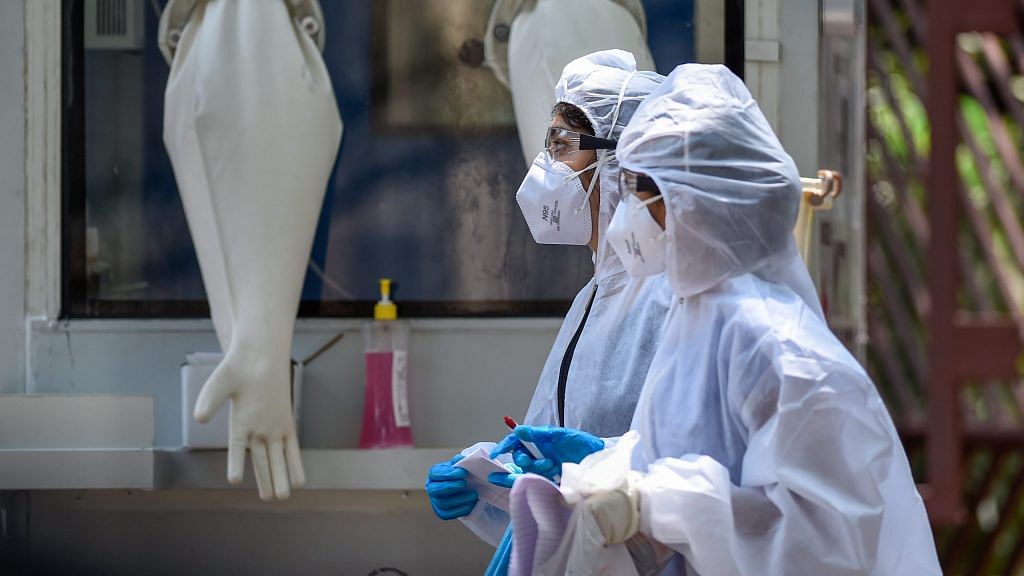The Indian Council of Medical Research on Saturday released its first data analysis of more than 10 lakh Covid-19 tests it conducted between 22 January and 30 April, of which over 40,000 were positive cases.
The analysis of this data contains five important lessons for India on how to move forward in terms of identifying and testing coronavirus positive persons.
Also read: India’s coronavirus fight lacks the most crucial thing in its arsenal — Data
Revive contact tracing
Unknown to most people, but now revealed by the Indian Council of Medical Research (ICMR) data, India’s contact tracing faltered a long time ago.
Of the 10 lakh plus people tested until 30 April, the mode of Covid-19 transmission is not known for 57 per cent of them. And of the 40,184 people who tested positive, the Narendra Modi government does not know how 44 per cent of them got infected, the ICMR has revealed. Worryingly, this number has only grown over time.
Compare this with South Korea, where the government updates citizens every day with anonymised information about the contacts of each new confirmed case; as of 30 May, just 9 per cent of South Korea’s Covid-19 cases have not yet been linked to existing cases, according to data from the Korea Centers for Disease Control and Prevention.
This applies even to newly discovered cases — just 7 per cent of the cases recorded in the last two weeks are still under investigation, while the source of infection in the rest of the cases has been identified.
Also read: ICMR to review ‘wonder’ drug combo used to treat Covid patients in Bangladesh
Push lagging states forward
Some states are struggling particularly hard with contact tracing. In Bihar and Odisha, the source of transmission is unknown for over 80 per cent of the people tested over three months, a clear indication that they are failing at contact tracing.
Without strong contact tracing, these states will be flying blind the next few months, unable to anticipate clusters and unsure where to direct testing resources.
Even relatively developed by high Covid-burden states such as Maharashtra and union territory Delhi are not doing enough contact tracing. Maharashtra, on average, tested 2.3 people per confirmed case and Delhi 2.1. Karnataka, which has had a low caseload so far, is a notable exception; it tested 47.4 contacts per confirmed case on average. Other states must learn from its successes.
Also read: ‘Govt relying on bureaucrats, not epidemiologists’: Top health experts slam Covid handling
Help family members mitigate risk
Among people for whom transmission details are available, the asymptomatic family members of confirmed cases form the largest segment of those both tested, and testing positive.
This should encourage state governments and city administrations to support individuals to quarantine and isolate safely; in high-density urban settings, the coronavirus has spread fast among family members, making them the largest affected group now. With the Modi government permitting those with mild and moderate symptoms to self-isolate at home since 27 April, the risk for family members will only grow.
Also read: Are people who have had Covid-19 immune? Perhaps not
Test marginalised groups more
Even though men and younger age groups are more affected by the pandemic in India, younger people and men are slightly more likely to get tested than they are to test positive.
To make up for this slight bias, India must boost the number of tests it conducts on women and older people. Many countries also report higher levels of deaths among minority groups; India does not have this information, but could consider boosting the numbers of those it tests from poor and marginalised communities.
Also read: 28% of 40,184 Covid positive cases in India till 30 April were asymptomatic: ICMR study
More asymptomatic random testing
The single largest group for whom details were available was not just family members of confirmed cases — it was asymptomatic family members of confirmed cases. This fact should help the Modi government refocus attention on testing asymptomatic people, preferably from random samples, given that it was unclear how the majority of those tested contracted the infection.
Whether these “unspecified” cases are on account of state governments doing an inadequate job of contact tracing or on account of widespread community transmission, the random testing of asymptomatic people will be the only way to stop the spread of coronavirus in its tracks.
The author is a Chennai-based data journalist. Views are personal.
